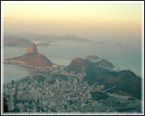Brazil: Air Pollution Control
 According to the specialized magazine “Quimica e Derivados” (Chemicals & Derivatives), the need to comply with existing legislation on pollution emissions, the reutilization of raw materials and adoption of environmentally friendly policies, are driving investments in air pollution control equipment and services. The magazine estimates that this market will increase by an estimate 20% per year. In addition to the industrial market, the increased number of Clean Development Mechanism (CDM) projects in sanitary landfills in Brazil is also creating a demand for air pollution technologies and services.
According to the specialized magazine “Quimica e Derivados” (Chemicals & Derivatives), the need to comply with existing legislation on pollution emissions, the reutilization of raw materials and adoption of environmentally friendly policies, are driving investments in air pollution control equipment and services. The magazine estimates that this market will increase by an estimate 20% per year. In addition to the industrial market, the increased number of Clean Development Mechanism (CDM) projects in sanitary landfills in Brazil is also creating a demand for air pollution technologies and services. The concentration of the population in urban areas (roughly 75% of all population) and industrial activities are the major causes of air pollution in Brazil. The most aggravating problem is emission of particulate materials by industries and vehicles, the major air polluters in Brazilian cities.
Automobiles are the major air polluters in Brazilian cities, however the Vehicle Air Pollution Control Program (Proconve), initiated in 1986, has helped address the problem. The average vehicular gas emission dropped by 94% in the last twenty years, despite an increase in the number of automobiles, from 10 million in 1986 to 25 million in 2006.
In 1986, the average emission of carbon monoxide was 54 grams per kilometer. In 2006, the figure had dropped to 0.3 gram per kilometer. The introduction of electronic injection systems to replace carburetors and the placement of catalytic converters in the automobiles at the plants, were key to reduced emissions.
Several Brazilian cities have air pollution measurement and monitoring programs in place. The Sao Paulo metropolitan region, which consists of 39 municipalities and 10% of Brazil’s population (about 17 million people), is South America’s largest metropolitan region. The prevailing pollution problem in the region is caused by photochemical oxidants (stratospheric ozone).
The state environmental agency, CETESB, has introduced several measures to minimize the problem, some of which include:
- Introduction of natural gas fuel for taxis and buses;
- Increased controls of large black gas generators (Pingelmann scale);
- Development of environmental programs and black smoke emission controls by owners of bus and truck fleets;
- Certification requirements for noise emission by cars, truck, buses and motorcycles since 1993;
- Restriction of automobile traffic once a week in the metropolitan region;
- Introduction of environmental parameters in public transportation bids;
- Attractive financing offered by low pollution public transportation system (ex. Electric transportation).
Although CETESB does not have updated survey on the major industrial air pollution generators, CETESB’s technical staff said that some of the major generators in the state are the sugar and alcohol plants; laundries; oil storage terminals; waste and sewage treatment plants, thermoelectric plants; beverage industry (odour issues); aluminum; chlorine and soda plants; foundries; glass and paint plants; pulp and paper; fertilizers and cement plants.
According to a CETESB source there has been a recent air pollution case in the Sao Paulo state, concerning fluorine emissions by red clay ceramic floor manufacturers. As a result of the contamination, CETESB established regulation (Portaria CETESB # 11) in July 10, 2003, imposing the emission parameter of 5 mg/FNm3 at 18% Oxygen for the ceramic floor industry.
The ceramic floor manufacturers are currently implanting fluoride emission control equipment to comply with the regulations, using dry and humid gas treatment technologies. The two technologies generate solid residues (dust retained in the baghouse filters or residues in the water circulation decanter), which can be reused in the industrial process.
Clean Development Mechanism Projects in Sanitary Landfills
The number of Clean Development Mechanism (CDM) projects in sanitary landfill operations in Brazil is expanding. This has created strong demand for gas capturing and burning and/or power generation, gas analysis and monitoring, and control and certification of methane emission reduction. The first CDM projects in sanitary landfills in Brazil were Nova Gerar in Rio de Janeiro and Vega in Bahia. There are several other projects in different development stages, such as Marca in Espirito Santo, Onix, Bandeirantes, Estre, Caieiras, Lara, Anaconda and Sao Joao in the Sao Paulo state.
CDM projects in Brazil are listed on the Ministério da Ciência e Tecnologia webisite.
You can return to the main Market News page, or press the Back button on your browser.

